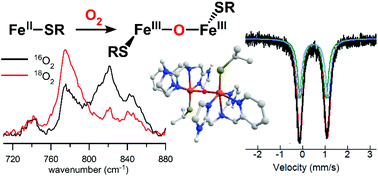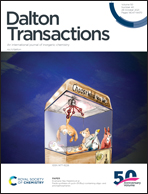Electronic structures and spectroscopic signatures of diiron intermediates generated by O2 activation of nonheme iron(ii)–thiolate complexes†
Abstract
The activation of O2 at thiolate–ligated iron(II) sites is essential to the function of numerous metalloenzymes and synthetic catalysts. Iron–thiolate bonds in the active sites of nonheme iron enzymes arise from either coordination of an endogenous cysteinate residue or binding of a deprotonated thiol-containing substrate. Examples of the latter include sulfoxide synthases, such as EgtB and OvoA, that utilize O2 to catalyze tandem S–C bond formation and S-oxygenation steps in thiohistidine biosyntheses. We recently reported the preparation of two mononuclear nonheme iron–thiolate complexes (1 and 2) that serve as structural active-site models of substrate-bound EgtB and OvoA (Dalton Trans. 2020, 49, 17745–17757). These models feature monodentate thiolate ligands and tripodal N4 ligands with mixed pyridyl/imidazolyl donors. Here, we describe the reactivity of 1 and 2 with O2 at low temperatures to give metastable intermediates (3 and 4, respectively). Characterization with multiple spectroscopic techniques (UV-vis absorption, NMR, variable-field and -temperature Mössbauer, and resonance Raman) revealed that these intermediates are thiolate-ligated iron(III) dimers with a bridging oxo ligand derived from the four-electron reduction of O2. Structural models of 3 and 4 consistent with the experimental data were generated via density functional theory (DFT) calculations. The combined experimental and computational results illuminate the geometric and electronic origins of the unique spectral features of diiron(III)-μ-oxo complexes with thiolate ligands, and the spectroscopic signatures of 3 and 4 are compared to those of closely-related diiron(III)-μ-peroxo species. Collectively, these results will assist in the identification of intermediates that appear on the O2 reaction landscapes of iron–thiolate species in both biological and synthetic environments.



 Please wait while we load your content...
Please wait while we load your content...
